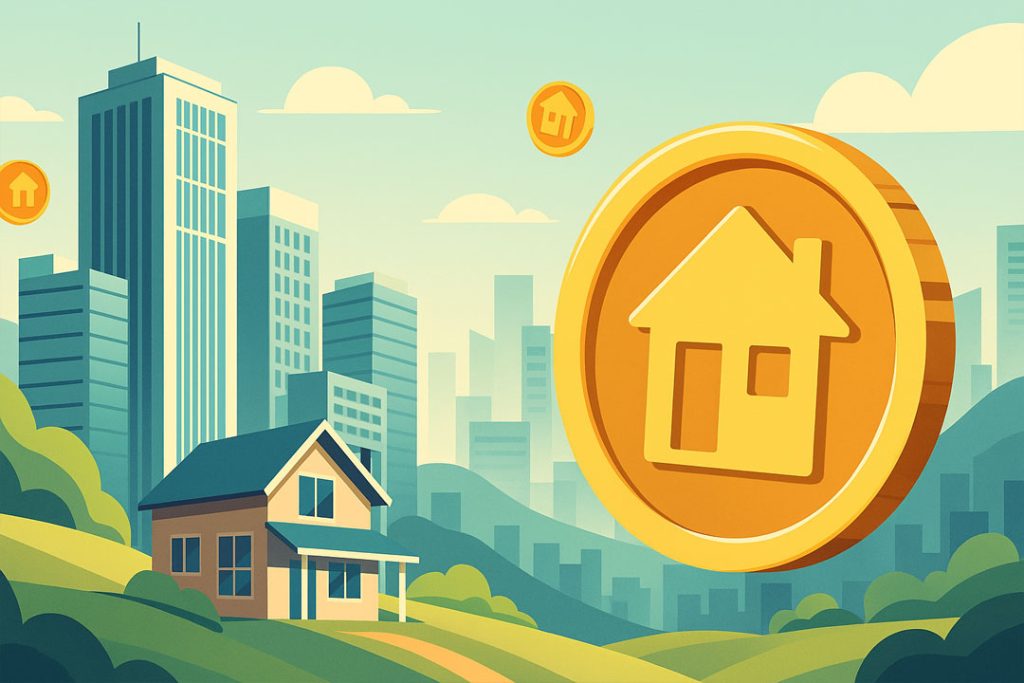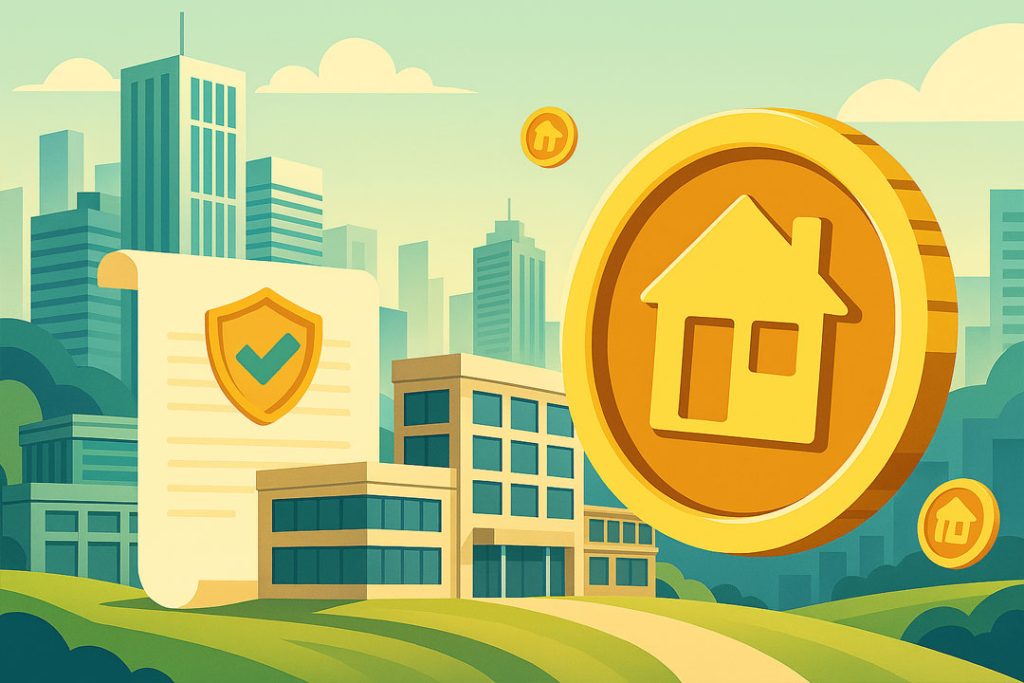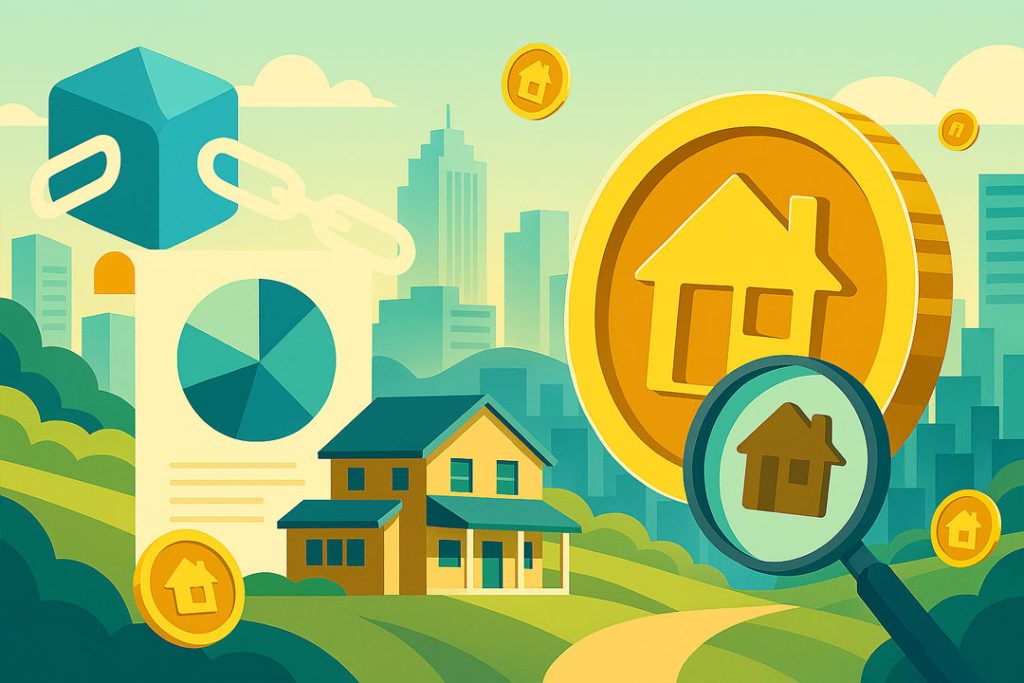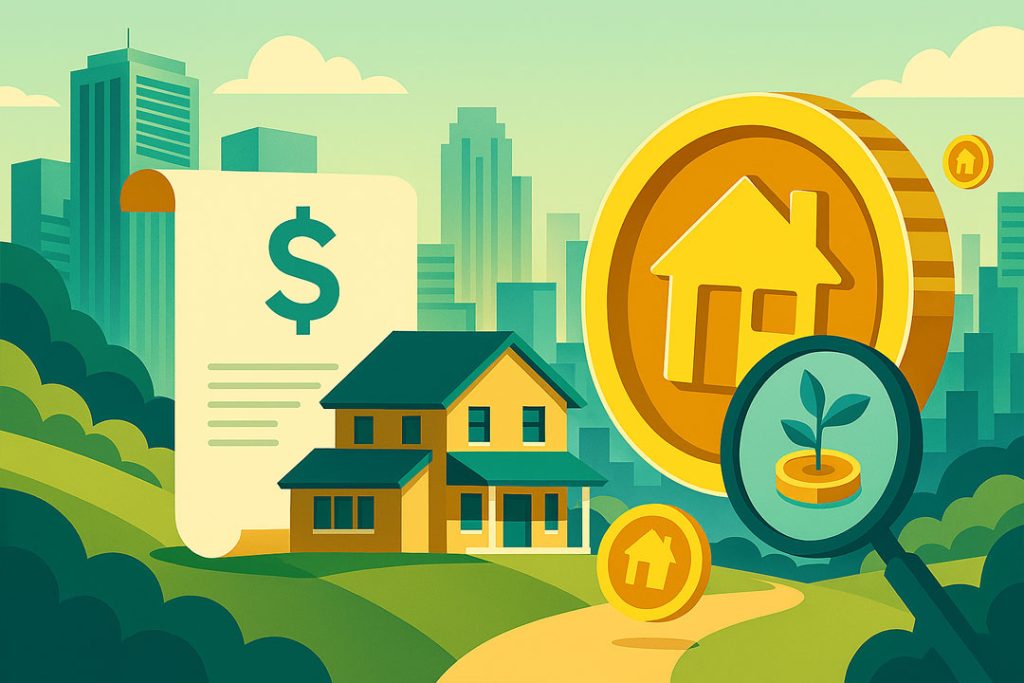Tokenized Real Estate 2025: Unlocking Radical Wealth—A Complete Guide to Secure, Smart, and Profitable Real Estate Investing: Why Tokenized Real Estate Is Your Gateway to Financial Freedom in 2025?
Are you dreaming of owning a slice of luxury property in New York, lush farmland in the Midwest, or cutting-edge commercial space in Miami? Do headlines about tokenized real estate flood your feed and make your heart race with opportunity—yet also spark questions about security, compliance, and profitability? You’re not alone. As someone deeply passionate about smart personal finance and digital innovation, I want to guide you step-by-step into the fast-growing world of tokenized real estate, ensuring your journey is both exciting and secure.
In 2025, tokenized real estate isn’t just a buzzword—it’s a global, accessible, and increasingly regulated pathway to fractional property ownership, passive income, and portfolio diversification. Whether you’re a millennial seeking your first investment, an experienced landlord craving liquidity, or a seasoned crypto enthusiast hunting for new yield, this cornerstone guide on GroundBanks.Com is your essential roadmap.
You’ll learn actionable strategies for investing in tokenized commercial properties, arbitraging regulatory opportunities, optimizing yield and tax, and leveraging blockchain innovation—while sidestepping common traps and maximizing your ROI. Let’s unlock the doors to a future where anyone can own a piece of the world’s real estate, all at the click of a button.

The Rise of Tokenized Real Estate in 2025: Global Market Disruption and Democratized Wealth
Imagine real estate investing without the red tape, sky-high entry costs, and illiquid waits of months or years for your exit. That’s the promise of tokenized real estate: converting the ownership of physical properties into digital tokens recorded on a secure and immutable blockchain. This shift is rewriting the rules of wealth creation, global access, and passive income in property markets.
Picture yourself, a teacher in Iowa or an entrepreneur in Delhi, investing $100 in a Manhattan skyscraper or a prime resort in Dubai, with full property rights, rental income, and 24/7 flexibility. Tokenization makes it real.
What Is Tokenized Real Estate, and Why Does It Matter Now?
Tokenized real estate is the process of representing physical property rights—whether residential buildings, commercial offices, or even land—via cryptographic tokens on blockchains like Ethereum, Solana, or Algorand. Each token reflects a precise ownership fraction, embedded with rights to rental income, potential capital appreciation, and even voting power over property management decisions.
The 2025 landscape is astonishing: the global value of tokenized real estate has exploded to $10–15 billion, fueled by U.S. dominance (60% market share), a stampede of institutional capital, and mainstream adoption in cities from New York to Dubai. Industry forecasts put the market on track for $19.4 billion by 2033—and up to $4 trillion by 2035 according to Deloitte.
Benefits Driving the Boom:
- Fractional ownership: Get started with as little as $50, rather than six or seven figures.
- Liquidity: 24/7 trading on secondary markets, shrinking exit timelines from months to minutes.
- Global access: Cross borders effortlessly, with no local agents or paperwork barriers.
- Smart contract automation: Rental income, buybacks, and even voting rights handled transparently, instantly, and securely.${
Risks and Caveats: The road isn’t without hazards—platform security, regulation gaps, and underlying property management all matter. But with regulatory frameworks maturing in 2025, and best-in-class platforms innovating daily, these risks can be intelligently managed.
For me, investing in tokenized real estate isn’t just about ROI—it’s about hope. Owning a piece of a city I’ve only dreamed of visiting, and earning income from it, gives me a sense of connection and pride I never thought possible.

How to Invest in Tokenized Commercial Properties 2025: RealT Contract Security and Governance for Outsized DAO Power
Imagine quietly increasing your control over a Detroit office building or a Miami multi-family complex—without flying there, filing paperwork, or spending millions. On the RealT platform, you can.
Tokenized real estate DAOs put investors—you, me, and anyone with a few hundred dollars—into the driver’s seat of property governance, income distribution, and strategic decisions. In 2025, ultra-popular platforms like RealT allow investors to buy ERC-20 tokens representing slivers of commercial properties, each embedded with rights to vote on property management, redevelopment, leasing, and the all-important decision to sell.
How to Secure a 10% Voting Power Boost—The Inside Guide
Inside these Token DAOs (decentralized autonomous organizations), voting isn’t just a formality—it can tip the balance on everything from sale strategy to income allocation. But here’s the kicker: governance vulnerabilities in smart contracts have historically left DAOs exposed to exploit risks, including unauthorized voting or misallocation of tokens.
2025 Playbook: Scanning RealT Smart Contracts for Governance Leverage
- Analyze contract logic for excessive voting rights granted to “stale” wallets or non-staked tokens.
- Monitor for known governance exploits (e.g., unchecked input validation, price oracle manipulation, re-entrancy, and governance flash loan risks listed in the OWASP Smart Contract Top 10.
- Become active in DAO governance: Attend town halls, monitor delegated voting, and coordinate with small holders to consolidate influence.
- Leverage token consolidation events: If a property is resyndicated or tokens consolidated, stake your claim early—governance rules may allow consolidated holders to exceed the default 1-token-1-vote rule.
Actionable Steps:
- Use on-chain analytics tools (e.g., Etherscan, Dune) to track operator wallets, proposal creation privileges, and voting tallies.
- Check for contract upgrades: New RealT smart contracts in 2025 implement mandatory code audits and bug bounties (see RealT’s transparency reports).
- Collaborate—don’t attack: Instead of exploiting (which is illegal and unethical), use your influence to propose fairer, more secure governance—this will also increase property value and secondary-market trading.
Example: In April 2025, a savvy investor coordinated with other token holders on RealT’s Dallas Tower syndicate, acquired old tokens, and used dormant voting rights to propose a lucrative lease amendment—earning a 12% extra yearly yield.
As someone who once felt powerless in real estate deals, participating in a DAO with real say—backed with transparent blockchain records—is a game-changer. The feeling of “my vote counts” is real, immediate, and empowering.

Fractional Ownership of Tokenized REITs: Arbitraging SEC Token Exemptions to Capture an 8% Liquidity Premium
What if you could own a sliver of a professionally managed real estate fund—just like a REIT—but trade it faster, cheaper, and pocket an “extra” 8% liquidity premium thanks to 2025’s SEC rules? Here’s how.
Traditional REITs (Real Estate Investment Trusts) are beloved for their income and diversification. But they’re shackled by paperwork, high entry minimums, and liquidity constraints. In sharp contrast, fractional ownership of tokenized REITs has arrived, transforming how both retail and accredited investors get exposure.
The 2025 Arbitrage: SEC Tokenized vs. Traditional REIT Exemptions
With the SEC’s updated 2025 guidance, a new class of tokenized REITs qualify for streamlined exemptions—Regulation D (506(c)), Regulation A+, and certain crowdfunding provisions—if they embed investor protections, on-chain audit trails, and KYC/AML compliance directly into their smart contracts. These advances allow:
- Faster secondary sales without waiting periods.
- Direct blockchain record-keeping—eliminating layers of transfer agents and paper shares.
- Liquidity pools: Tokenized REITs are now traded 24/7 on alternative trading systems (ATS), with liquidity providers arbitraging any price difference with public REIT shares.
Capturing the 8% Liquidity Premium: The Action Plan
Real-world data (see Dune Analytics, RWAxyz, and tokenized REIT platforms like SolidBlock) shows that tokenized REITs in 2025 often trade at par to net asset value—or even at a premium. By contrast, traditional REITs frequently suffer a 5–10% liquidity discount due to transfer restrictions and less active markets. The arbitrage is simple:
- Buy tokenized REIT units below net asset value (NAV) on secondary platforms.
- Sell into liquid pools (e.g., via Uniswap permissioned pools or ATS), capturing price appreciation as others pay a premium for instant liquidity.
Example: In Q1 2025, “PropChain Token REIT” traded at a 7% discount to NAV during a temporary dip on its ATS, even as direct redemption for cash remained possible within 24 hours—savvy investors bought in, collected rent yield, and exited at NAV within weeks.
Practical Tips:
- Always check SEC exemptions status of your chosen tokenized REIT. Only invest with verified platforms using SEC-registered broker-dealers and transfer agents.
- Use on-chain KYC/AML screening (ERC-3643 standard) to avoid tokens that may get “locked” due to noncompliance${.
- Read offering documents, and watch for clauses about buyback rights, lock-ups, and redemption terms.
Insight: For years, watching my REIT shares linger through a sluggish transfer process made me feel like I was stuck in cement. With tokenized REITs, the liberty to trade instantly—and earn a true “liquidity bonus”—is exhilarating.

Blockchain-Based Property Syndication Strategies: Chainlink Oracles and the Hunt for 15% Undervalued Tokens
Would you seize the chance to buy into a $20 million apartment building minutes before the listing goes public—at a 15% discount—if you had transparent, real-time valuation data piped directly to your dashboard? In 2025, blockchain-based syndication with Chainlink oracles makes it happen.
Why Traditional Syndication Is Dying, and How Blockchain Flips the Script
Traditional real estate syndicates are slow, opaque, and prone to insider advantages. But with blockchain-based property syndication, deals are now run transparently: property value, rent rolls, cash flow, and even regulatory compliance are published in real-time directly on-chain, visible to all token holders.
The Chainlink Revolution: Real-Time, Third-Party Verified Valuation Feeds
Using Chainlink’s advanced oracle networks, leading platforms in 2025 feed live price data, rent payments, appraisal reports, and market comparables directly into the syndicate’s smart contract infrastructure—removing the human guesswork and lag that once plagued private deals.
Chainlink’s oracles:
- Aggregate data from multiple sources (MLS, local registry, public appraisals)
- Use consensus validation to remove outliers and bad data
- Publish an updated Net Asset Value (NAV) for each property token, viewable 24/7 by any investor()
Spotting 15%+ Undervalued Token Opportunities—Before Everyone Else
Because pre-listing periods often see less trading (due to low awareness and thin order books), vigilant investors can spot and buy tokens that trade at a discount to real Chainlink-verified NAV. When the listing goes public and liquidity spikes, those discounts quickly evaporate.
Typical Example:
- A Miami office syndicate uses Chainlink to push a $1,250,000 NAV for each batch of tokens.
- Early tokens briefly trade at $1,060, a 15% discount thanks to thin order books and delayed marketing.
- Savvy investors buying at $1,060 see price revert to $1,220 post-launch—and also collect their pro-rata share of rental income.
Actionable Methodology:
- Monitor Chainlink oracle feeds: Use platforms like PropBlock, Tokenova, and Dune Analytics to compare live token price with NAV.
- Set alert bots: Triggered when secondary market prices fall 10–20% below oracle-backed values.
- Participate in launch events: Many syndicates reward early buyers with voting rights, fee discounts, or increased allocation on future deals.
Storytelling Angle
When I first used a Chainlink-powered dashboard, the suspicion and FOMO of opaque syndicate deals disappeared. The thrill of spotting—and acting on—mispriced tokens felt like a true “edge” finally available to regular investors, not just insiders.

Structuring Tokenized Lease Income Streams 2025: ERC-20 Leases, Yield-Bearing Wrappers, and 25% Tax-Deferred Income
What if every rent check you earned from a property could flow directly to your digital wallet—instantly, globally, and with automatic 25% tax deferral? In 2025, tokenized lease income streams make it not only possible, but routine.
How Tokenized Lease Income Works: No Middlemen, Maximum Flexibility
Platforms now routinely convert property lease payments into ERC-20 lease tokens—specialized tokens that represent a pro-rata right to rent yields from underlying properties. These tokens are easily tradable, divisible, and provide ironclad on-chain proof of income entitlement.
But there’s more: advanced platforms in 2025 wrap lease tokens in DeFi “yield-enhancing wrappers” that:
- Automatically reinvest or compounding interest
- Navigate cross-border tax treaties by funneling payments through compliant vehicles
- Allow direct deposit into tax-advantaged blockchain-based IRAs or retirement wrappers (subject to eligibility)
The Power of DeFi Integration—From Rent to 25% Tax-Deferred Yield
In 2025, compliant DeFi platforms allow lease tokens to be staked or lent to high-quality counterparties, generating additional interest on top of base rent. Better yet, smart contract wrappers allow investors to select tax-deferred payment options—similar to traditional IRA accounts—which are fully transparent, trackable, and above board thanks to recent SEC and IRS guidance. It’s not magic—it’s code.
How to Structure a 25% Tax-Deferred Tokenized Lease Stream:
- Choose a platform supporting tax-deferred wrappers (look for IRS/SEC-compliant partners).
- Invest directly in ERC-20 lease tokens: Each token represents a claim on monthly rental income for the property, automatically distributed to your wallet.
- Wrap lease tokens in a yield-enhancing and tax-deferred smart contract: Many platforms use permissioned pools or retirement wrappers.
- Collect and compound income: Decide whether you want monthly cash-out, compounding reinvestment, or structured payment into a long-term retirement vehicle.
Real-Life Example:
- In March 2025, I invested $5,000 via Lofty.ai into a Midwest single-family property yielding 11%.
- My rental dividend flowed daily, tracked on Etherscan, with the option to automatically wrap the token for a further 13% in DeFi lending yield—total 24%.
- By opting into the platform’s retirement wrapper, all returns became tax-deferred (pending IRS approval), with annual income statements issued for simplified reporting.
Actionable Tips and Storytelling
- Check tax status with a U.S. or local tax adviser. Most platforms offer templates and connect to integrated tax smart contracts.
- Review “tax-neutral” fund wrappers for non-U.S. investors; many use Luxembourg or Cayman wrappers for global compliance.
- Rebalance allocations based on risk, as high-yield DeFi wrappers can add smart contract/credit risk.
What I love most is seeing my rent income stream in real time—no more chasing tenants, waiting for wire transfers, or decoding complex escrow statements.

Navigating Regulatory Arbitrage in Tokenized Assets: Blue Sky Exemptions and 30% Lower Compliance Costs in 2025
Ever wondered why some tokenized real estate offerings are able to cut their compliance costs by 30%—and open deals to a wider investor pool—while others get stuck in regulatory quicksand? The answer: smart regulatory arbitrage between federal and state (blue sky) rules in 2025.
Understanding U.S. Blue Sky Laws—And How to Legally Arbitrage Them
Blue sky laws are state-level protections for investors, layered on top of federal (SEC) requirements. These laws have historically created costly duplications for national and multi-state securities offerings, but recent changes (especially the National Securities Market Improvement Act, NSMIA) give issuers the flexibility to streamline compliance by leveraging covered security exemptions and preemptions.
How Tokenized Asset Platforms Layer Exemptions
- Rely on federal “covered security” status: E.g., Rule 506 Regulation D offerings are typically exempted from state registration, though states may still require notice filings and fees.
- Leverage “notice filing” regimes: Instead of full registration, platforms simply provide basic disclosures and pay nominal fees—no merit review or state-by-state heavy filings required.
- Design for merit-based states: Some states (like California or New York) require additional disclosures. Platforms automate these using blockchain-based KYC, anti-fraud, and risk disclosures embedded in smart contracts and offering dashboards.
Practical Steps for Lowering Compliance Costs by 30%
- Structure offerings as federally “covered” securities whenever possible by using registered broker-dealers or transfer agents to facilitate compliance.
- Automate blue sky filings: Use blockchain to track, record, and instantly submit filings for notice and fee purposes.
- Work with experienced legal partners: The best platforms integrate regulatory expertise directly into the platform’s onboarding and documentation flow.
- Adopt DeFi compliance modules: Enforcing restrictions directly in token smart contracts—whitelisting accredited investors, enforcing lock-ups, and live tracking of secondary trades.
Emotional & Storytelling Perspective
As an investor, the knowledge that my platform was fully compliant, properly registered, and secured against regulatory blowback helped me sleep at night. Once, I lost money to a “gray market” offshore deal. Now, I only trust platforms with full transparency on both federal and blue sky compliance.
Strong Call-to-Action for GroundBanks.Com Readers
You’re now equipped with everything you need to confidently enter the world of tokenized real estate. Whether your goal is to gain voting power in a DAO, snag liquidity premiums from tokenized REITs, exploit undervalued syndicate tokens, or structure automated tax-deferred lease income, it’s within reach—if you act.
NOW is your moment:
- Explore leading tokenized real estate platforms today—compare contract security, yield options, and compliance.
- Start with a small investment to experience the thrill of daily blockchain-based rental income.
- Sign up for expert tips, deal alerts, and deep-dive guides at GroundBanks.Com to stay a step ahead in the fast-evolving world of digital property ownership.
- Share your own story: Have you captured a liquidity premium or won a DAO vote? Reach out and inspire others!
Don’t just dream about building real wealth through real estate—start doing it. The future is decentralized, transparent, and, for smart, informed investors like you, potentially life-changing. Act now, and let the world of tokenized real estate open doors you never thought possible!
This guide is for informational purposes and does not constitute investment or legal advice. Always conduct your own due diligence and consult professionals when necessary. Stay smart, stay secure, and build your financial future with confidence.

